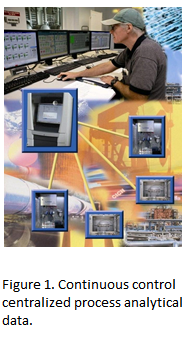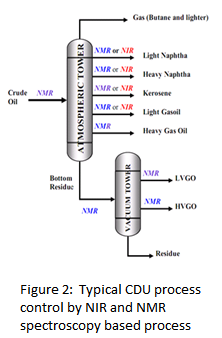RL Blogs

By Modcon-Systems Ltd.
Oct 01, 2018Increase refinery efficiency and profitability through the application of on-line process instrumentation. |
||||
|
Contributed by: Gregory Shahnovsky, Tal Cohen, Ronny McMurray
In the past refineries distilled predominately the same crude oil to provide a stable range of refinery products to their domestic customers. Nowadays, to survive in the competitive environment in the petroleum business and the ease of worldwide transportation, refineries are obliged to increase their refining margin.
To achieve this goal, refineries are obliged to continuously change their product range toward those products with the highest market values, or dictated by seasonal consumption fluctuations of different refinery products. Operating refineries in an efficient and profitable manner requires achieving maximum capacity at lowest production cost, which is achieved by:
Refineries are unique in their complexity as a chemical plant. Many processes are interlinked, where the product of one process unit serves the feedstock for another process. This means that when one process fails to run in its optimized mode it will affect the entire production chain, up to the final product.
Secondly, financial losses of one process unit that is not running at maximum efficiency can be that high that it is not covered by the profit of other process units. Laboratory analyzes are long-lasting. The response time from sampling until providing analyses to the production unit is time consuming due to analytical methods as well as from a human resource point of view.
Each sample must undergo several analyses to ensure the product to comply with is specification and the process to run as required. In case of discrepancy between the specification and the analytical results, off spec material is produced for a certain period of time, which must undergo costly reprocessing.
To prevent any unnecessary economic losses to the refinery requires overseeing the entire refinery processes at any time, by collecting on-line and real time data about the physical properties of feed and product streams alike, and refers to individual production unit. Continuous monitoring of physical properties in process streams is inevitable to operators, for optimizing the process conditions as such that at any time all units run in an economic mode.
On-line monitoring enables operators to decide whether process conditions must be adjusted, and if so, what is the feedback of the process from the changes made. Implementation of on-line process analyzer are the fundamentals towards effective process control.
Further to that, the engineering of conventional ASTM based process analyzers, like RON/MON/Cetane analyzers, include many moving and wearing mechanical parts. This entails high costs of maintenance, keeping a stock of different expensive spare-parts for “just in case”, and technicians trained specific for each analyzer. When required spare parts are not at hand, or when the analyzer cannot be isolated from the process stream proper production continuation is endangered.
Replacing discrete ASTM based analyzer by correlative analyzers reduces the prolonged time of analyses in combination with high cost of maintenance. These analyzers are commonly based on the correlation of spectral data with quantified values of physical properties.
According to the Lambert Beer laws, the absorbance of light is proportional to the concentration of a substance in a composition. Overall physical properties are the outcome of the contribution of each individual substance present in a composition. Based on those fundamentals, chemometrics links mathematically between quantified physical properties and the spectral response.
Establishment of accurate and reliable correlation curves enables replacing ASTM based analyzer by a correlative analyzer, enabling on-line process control. Petroleum products are normally marketed according legislative standardized methods and specifications.
The presence of even minor but varying substances not covered by the calibration curve, like asphaltenes in distillates, or overlapping spectral bands are common root causes for deviations between predicted results and "real measurements".
Correlative analyzers do not replace laboratory analyses for final certification, but reduce drastically the amount of a laboratory must performed for process control. Only one set of analyzes is required per tank to approve its entire content. A major advantage of correlative analyzers over ASTM based analyzers is their simplicity.
means that there is no need any more to purchase and maintain a huge stock of different spare parts, and an enormous investment in cost of maintenance keep analyzers running.
Reliability as is a major requirement in process control. This means that full harmony must exist between correlative analyzers and ASTM based laboratory analyses. Freetune® is a propriety software that validates, verifies and auto- adjusts analytical results from correlative analyzers based on laboratory measurements or from measurements performed by discrete standardized method based process analyzers.
Continuously it compares between correlative analyzer results and laboratory results, which represent the same point of time. Incorporation of preferably on-line correlative analyzers, with incorporated model validation software forms the basics for operators to run refinery processes in optimized conditions.
However, analytical results must also be displayed users friendly to the operator. Clear provision of an entire overview of the various quality measurements in a refinery unit, and their presentation to the operator are primary tools to the operators, when changing or adjusting process parameters.
Immediate feed-back to the operators a response to the changes in process conditions made is crucial in modern concepts of process optimization. It minimizes losses due to quality lacks and to too a low capacity rate. It contributes to the elimination of reprocessing, and process adjustment in case of feed variations.
Its complexity makes refineries to be very sensitive to easy losses of thousands, or even millions of dollars. Shifting from conventional process control to spectroscopy-based technologies, such as NIR and NMR, will be a step forward in eliminating these undesired costs.
Common KPI’s that represent critical economic parameters such as the production yields, production capacities, reprocessing, off-spec or borderline production, will definitely prove within a short the high efficiency that can be reached by application of on-line process analyzers.
About Modcon Systems Modcon Systems specializes in performing process control automation, instrumentation and analyzer projects with turn-key delivery, support and training. Modcon-Systems Ltd. product line includes On-line Process Analyzers and Systems, Process Control & Automation, SCADA and Industrial Network Solutions, Environmental Control, Gas Detectors and Air Pollution Analyzers. Modcon-Systems Ltd. specialty analyzers include the Beacon 3000 NIR Process Analyzer and the MOD 8000 NMR Process Analyzer. | ||||
|
|











